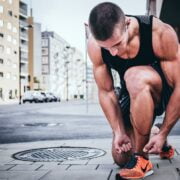
Bootylicious: Top Glute Exercises for Building Strong and Toned Glute Muscles
Having strong glutes is not just about having a nice-looking backside. Strong glutes are essential for overall fitness and can have a significant impact on your posture, risk of injury, and athletic performance. The glute muscles, which include the gluteus maximus, gluteus medius, and gluteus minimus, are the largest muscles in the body and play a crucial role in stabilizing the pelvis, supporting the spine, and generating power during movement.
One of the key benefits of having strong glutes is improved posture. Weak glutes can lead to an anterior pelvic tilt, which causes the lower back to arch excessively and the hips to tilt forward. This can result in poor posture and put strain on the lower back. By strengthening the glutes, you can help correct this imbalance and maintain a more neutral spine position.
In addition to improving posture, strong glutes can also reduce the risk of injury. The glutes help stabilize the pelvis and support the hips and knees during movement. Weak glutes can lead to imbalances in these areas, which can increase the risk of injuries such as knee pain, hip pain, and lower back pain. By strengthening the glutes, you can help prevent these injuries and improve overall joint stability.
Furthermore, strong glutes can enhance athletic performance. The glutes are responsible for generating power during movements such as running, jumping, and lifting. By strengthening these muscles, you can improve your ability to generate force and power in these activities. This can lead to improved speed, agility, and overall athletic performance.
Key Takeaways
- Strong glutes are important for overall fitness and can improve posture, balance, and athletic performance.
- Warm-up exercises like glute bridges and hip circles can help prepare your glutes for a workout.
- Squats are the ultimate glute-building exercise and can be modified for different fitness levels.
- Lunges can target different areas of the glutes and can be done with or without weights.
- Deadlifts, hip thrusts, step-ups, and plyometric exercises can all help strengthen and tone the glutes.
Warm-Up Exercises to Prepare Your Glutes for the Workout
Before diving into a glute workout, it is important to properly warm up your muscles to prevent injury and prepare them for the upcoming exercises. A good warm-up routine should include dynamic stretches and movements that target the glutes and activate the muscles.
One effective warm-up exercise for the glutes is hip circles. Stand with your feet hip-width apart and place your hands on your hips. Slowly rotate your hips in a circular motion, making sure to engage your glutes throughout the movement. Perform 10 circles in one direction and then switch to the other direction.
Another great warm-up exercise is leg swings. Stand next to a wall or support and hold onto it for balance. Swing one leg forward and backward, keeping it straight and engaging your glutes. Perform 10 swings on each leg.
Glute bridges are also an excellent warm-up exercise for the glutes. Lie on your back with your knees bent and feet flat on the ground. Engage your glutes and lift your hips off the ground, creating a straight line from your knees to your shoulders. Hold for a few seconds and then lower back down. Repeat for 10-15 reps.
Squats: The Ultimate Glute-Building Exercise
When it comes to building strong glutes, squats are often considered the ultimate exercise. Squats target not only the glutes but also other lower body muscles such as the quadriceps, hamstrings, and calves.
To perform a squat, stand with your feet shoulder-width apart and toes slightly turned out. Engage your core and keep your chest lifted as you push your hips back and bend your knees to lower into a squat position. Make sure to keep your knees in line with your toes and avoid letting them collapse inward. Push through your heels to return to the starting position.
Proper form is crucial when performing squats to effectively target the glutes. It is important to maintain a neutral spine throughout the movement and avoid rounding or arching the lower back. Additionally, make sure to engage your glutes as you push through your heels to stand up from the squat.
There are also variations of squats that can target the glutes in different ways. Goblet squats, for example, involve holding a dumbbell or kettlebell at chest level while performing the squat. This variation places more emphasis on the glutes and can help improve hip mobility.
Sumo squats are another variation that targets the glutes. In this variation, you take a wider stance with your toes turned out at a greater angle. This wider stance allows for greater activation of the glutes and inner thighs.
Lunges: Variations to Target Different Areas of the Glutes
| Lunge Variation | Targeted Area of Glutes | Difficulty Level |
|---|---|---|
| Forward Lunge | Gluteus Maximus | Beginner |
| Reverse Lunge | Gluteus Maximus, Hamstrings | Intermediate |
| Curtsy Lunge | Gluteus Medius, Gluteus Minimus | Intermediate |
| Side Lunge | Gluteus Medius, Gluteus Minimus | Intermediate |
| Walking Lunge | Gluteus Maximus, Gluteus Medius, Gluteus Minimus | Advanced |
| Jumping Lunge | Gluteus Maximus, Gluteus Medius, Gluteus Minimus | Advanced |
Lunges are another effective exercise for targeting the glutes and can be performed in various ways to target different areas of the glutes.
Walking lunges are a great way to engage the glutes while also working on balance and coordination. To perform walking lunges, start by standing with your feet hip-width apart. Take a step forward with your right foot and lower your body into a lunge position, making sure to keep your front knee in line with your ankle. Push through your front heel to stand up and bring your back foot forward into the next lunge. Repeat for 10-12 lunges on each leg.
Reverse lunges are another variation that targets the glutes. Instead of stepping forward, you step backward into a lunge position. This variation places more emphasis on the glutes and hamstrings.
Lateral lunges are another effective variation for targeting the glutes. Start by standing with your feet wider than shoulder-width apart and toes turned out. Shift your weight to one side as you bend that knee and lower into a lunge position, keeping the other leg straight. Push through the heel of the bent leg to return to the starting position and repeat on the other side.
Deadlifts: Strengthening the Glutes and Hamstrings
Deadlifts are a compound exercise that targets multiple muscle groups, including the glutes and hamstrings. They are a great exercise for building strength and power in the lower body.
To perform a deadlift, stand with your feet hip-width apart and toes slightly turned out. Bend at the hips and knees to lower your hands to the barbell, keeping your back straight and chest lifted. Grip the barbell with an overhand grip, slightly wider than shoulder-width apart. Engage your core and glutes as you push through your heels to stand up, lifting the barbell off the ground. Make sure to keep your back straight throughout the movement. Lower the barbell back down to the ground by bending at the hips and knees.
Proper form is crucial when performing deadlifts to effectively target the glutes and hamstrings while minimizing the risk of injury. It is important to maintain a neutral spine throughout the movement and avoid rounding or arching the lower back. Additionally, make sure to engage your glutes as you stand up from the deadlift to fully activate the muscles.
There are also variations of deadlifts that can target the glutes and hamstrings in different ways. Romanian deadlifts, for example, involve keeping a slight bend in the knees throughout the movement and focusing on hinging at the hips. This variation places more emphasis on the hamstrings and can help improve hip mobility.
Single-leg deadlifts are another variation that targets the glutes and hamstrings while also challenging balance and stability. To perform a single-leg deadlift, stand on one leg with a slight bend in the knee. Hinge at the hips and lower your upper body towards the ground while extending your other leg straight behind you. Engage your glutes and hamstrings to return to the starting position.
Hip Thrusts: Isolating the Glute Muscles for Maximum Results

Hip thrusts are an excellent exercise for isolating the glute muscles and maximizing glute gains. They target the gluteus maximus, the largest muscle in the glute complex, and can help build strength and size in this area.
To perform a hip thrust, start by sitting on the ground with your back against a bench or elevated surface. Place a barbell or weight across your hips. Bend your knees and place your feet flat on the ground, hip-width apart. Engage your glutes and push through your heels to lift your hips off the ground, creating a straight line from your knees to your shoulders. Squeeze your glutes at the top of the movement and then lower back down.
Proper form is crucial when performing hip thrusts to effectively target the glutes while minimizing the risk of injury. It is important to maintain a neutral spine throughout the movement and avoid arching or rounding the lower back. Additionally, make sure to engage your glutes as you lift your hips off the ground to fully activate the muscles.
There are also variations of hip thrusts that can target the glutes in different ways. Banded hip thrusts, for example, involve placing a resistance band around your thighs just above your knees. This variation adds extra resistance and places more emphasis on the glutes.
Single-leg hip thrusts are another variation that targets each glute individually while also challenging balance and stability. To perform a single-leg hip thrust, start in the same position as a regular hip thrust but extend one leg straight out in front of you. Engage your glutes and push through your heel to lift your hips off the ground, focusing on using the working leg to drive the movement.
Glute Bridges: A Low-Impact Exercise for All Fitness Levels
Glute bridges are a low-impact exercise that can be suitable for all fitness levels. They are an excellent exercise for targeting the glutes while also engaging the core and hamstrings.
To perform a glute bridge, lie on your back with your knees bent and feet flat on the ground. Place your arms by your sides with your palms facing down. Engage your glutes and core as you lift your hips off the ground, creating a straight line from your knees to your shoulders. Squeeze your glutes at the top of the movement and then lower back down.
Proper form is crucial when performing glute bridges to effectively target the glutes while minimizing the risk of injury. It is important to maintain a neutral spine throughout the movement and avoid arching or rounding the lower back. Additionally, make sure to engage your glutes as you lift your hips off the ground to fully activate the muscles.
There are also variations of glute bridges that can target the glutes in different ways. Elevated glute bridges, for example, involve placing your feet on an elevated surface such as a bench or step. This variation increases the range of motion and places more emphasis on the glutes.
Frog pumps are another variation that targets the glutes. To perform frog pumps, lie on your back with your knees bent and feet together, soles touching. Push through your heels to lift your hips off the ground, squeezing your glutes at the top of the movement.
Step-Ups: Building Glute Strength and Endurance
Step-ups are a great exercise for building glute strength and endurance while also engaging other lower body muscles such as the quadriceps and calves.
To perform a step-up, stand in front of a step or elevated surface with your feet hip-width apart. Step one foot onto the step and push through that heel to lift your body up onto the step. Make sure to fully extend your hip at the top of the movement and engage your glutes. Step back down with control and repeat on the other leg.
Proper form is crucial when performing step-ups to effectively target the glutes while minimizing the risk of injury. It is important to maintain a neutral spine throughout the movement and avoid arching or rounding the lower back. Additionally, make sure to engage your glutes as you lift your body up onto the step to fully activate the muscles.
There are also variations of step-ups that can target the glutes in different ways. Lateral step-ups, for example, involve stepping onto the side of a step or elevated surface instead of stepping directly in front. This variation places more emphasis on the gluteus medius, which is located on the side of the hip.
Box jumps are another variation that targets the glutes while also adding an explosive element to your workout. To perform box jumps, start by standing in front of a sturdy box or elevated surface. Bend your knees and swing your arms back as you prepare to jump. Explosively jump onto the box, landing softly with your knees bent. Step back down with control and repeat for 10-12 jumps.
Plyometric Exercises: Adding Explosive Movements to Your Glute Workout
Plyometric exercises are a great way to add explosive movements to your glute workout and further challenge your muscles. These exercises involve quick, powerful movements that help improve power, speed, and overall athletic performance.
Jump squats are a popular plyometric exercise that targets the glutes while also engaging other lower body muscles such as the quadriceps and calves. To perform jump squats, start by standing with your feet shoulder-width apart. Lower into a squat position and then explosively jump up, extending your hips and knees. Land softly with your knees bent and immediately lower back into a squat position to repeat the movement.
Jump lunges are another plyometric exercise that targets the glutes while also challenging balance and coordination. To perform jump lunges, start in a lunge position with your right foot forward and left foot back. Lower into a lunge position and then explosively jump up, switching the position of your feet in mid-air. Land softly with your left foot forward and right foot back, immediately lowering into a lunge position to repeat the movement.
Box jumps, mentioned earlier in the step-ups section, are another plyometric exercise that targets the glutes while also adding an explosive element to your workout. To perform box jumps, start by standing in front of a sturdy box or elevated surface. Bend your knees and swing your arms back as you prepare to jump. Explosively jump onto the box, landing softly with your knees bent. Step back down with control and repeat for 10-12 jumps.
Cool-Down Stretches to Prevent Injury and Improve Flexibility
After completing a glute workout, it is important to properly cool down and stretch to prevent injury and improve flexibility. Cooling down helps bring your heart rate and breathing back to normal gradually, while stretching helps lengthen and relax the muscles.
One effective cool-down stretch for the glutes is pigeon pose. Start in a high plank position and bring your right knee forward towards your right hand. Slide your left leg back behind you, keeping it straight. Lower your upper body down towards the ground, resting on your forearms or forehead. Hold for 30 seconds to one minute and then switch sides.
Seated forward fold is another great stretch for the glutes. Sit on the ground with your legs extended in front of you. Reach forward with both hands and try to touch your toes. Keep your back straight and engage your core as you fold forward. You should feel a deep stretch in your glutes and hamstrings. Hold this position for 30 seconds to a minute, breathing deeply and relaxing into the stretch. Remember to listen to your body and only go as far as is comfortable for you. Regular practice of seated forward fold can help improve flexibility in the glutes and promote better posture.
FAQs
What are glute muscles?
Glute muscles, also known as glutes, are a group of three muscles located in the buttocks: the gluteus maximus, gluteus medius, and gluteus minimus.
Why is it important to strengthen glute muscles?
Strengthening glute muscles can improve posture, reduce lower back pain, increase athletic performance, and enhance overall physical appearance.
What are some effective glute exercises?
Some effective glute exercises include squats, lunges, deadlifts, hip thrusts, and glute bridges.
How often should I do glute exercises?
It is recommended to do glute exercises at least 2-3 times per week, with a rest day in between each workout.
Can I do glute exercises at home?
Yes, there are many glute exercises that can be done at home with little to no equipment, such as bodyweight squats, lunges, and glute bridges.
How long does it take to see results from glute exercises?
Results can vary depending on individual factors such as genetics, diet, and exercise routine. However, with consistent effort and proper form, noticeable results can typically be seen within 4-6 weeks.


















